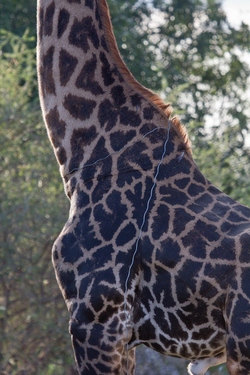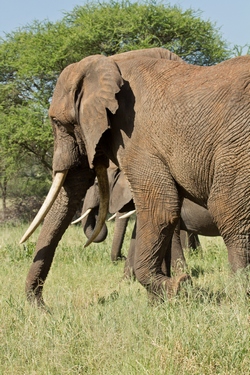
This Maasai giraffe has been caught in a
poachers snare but has managed to break free.
However, the snare remains in place and should
the loose end catch up in a large bush or tree
then it will tighten up and kill the giraffe.
Poaching is too quaint a term for what is going on. It conjures up a picture of a desperately poor man taking a much needed small animal for the pot in order to feed his starving children.
In some cases that may indeed be the scenario, but what I'm talking about is the callous and wholesale slaughter of entire species in industrial scale operations motivated by sheer greed.
Poaching can take many forms. Wire snares, metal traps, pitfalls, and spears arranged to fall from trees and kill passing game. More active methods include the use of bows, and spears. Then we move up an order of magnitude to firearms. Anything from old single shot rifles, to modern hunting weapons and military style semi automatic weapons. Coupled with high technology such as GPS systems, mobile phones, and even helicopters, poaching becomes an incredibly efficient and destructive method of wiping out whole populations of animals from vast areas in a very short timescale.
There are recent incidents of herds of elephants being systematically shot through the top of the head from helicopters. And then there is the poisoning option. It's easy to tip cyanide into a waterhole and kill hundreds of animals indiscriminately, just for the sake of a few elephant tusks.
Make no mistake there are massive amounts of money involved. Around $19 Billion dollars annually has been estimated, including the bushmeat trade.
Poaching is currently seen as a low risk, high reward option by many criminals, especially those not in the front line. Punishments in many countries are ridiculously lenient as poaching has not yet been recognised as a serious problem in much of the World and is still treated as a misdemeanour.
Indeed, in a society of extreme poverty, the man who supplies his extended family with bushmeat is viewed upon in a sort of Robin Hood manner by his peers. And the man who has plenty of dollars to spend in an impoverished community is boosting the general level of income in the area. The fact that he may have earned that money by killing a rhino does not bother most of his neighbours. Game is often seen as a nuisance, especially to a farming community who are repeatedly subjected to often devastating crop raids by animals such as elephants, and receive little or no compensation when it happens.
Therefore it is easy for criminal operations to recruit foot soldiers. Poverty and desperation, coupled with the offer of what amounts to a huge payoff will ensure that there is a continuous supply of young men willing to risk their lives to go killing game animals, particularly the high value ones such as elephants and rhino.
The other factors helping poaching operations are more systemic. Many African countries are subject to bad governance and corruption. The two tend to go hand in hand. In some countries People are appointed to jobs for reasons of political expediency, or as payback for past favours, or even along tribal lines. Consideration for their suitability or competence for the position is often of no concern. The corrupt goverment is only interested in staying in power, and making obscene amounts of money for the senior individuals within it.

35000 elephants were brutally murdered for
their Ivory in 2013. Young or old, none are safe
from the ruthless criminals who organise this
crime.
Often the police, the judiciary, the wildlife services and the politicians in charge of them are the very people who are organising the huge poaching operations within their own country. Bribery is rife and government organisations are used to facilitate the slaughter, and the subsequent movement of ivory, horns, skins, and other body parts, out of the country.
So what can be done to stop it? It is very difficult to stop a major poaching operation without absolute commitment from the highest echelons of government. My own view is that 'people power' will eventually force the corrupt regimes to curb their excesses. With the increase in education that is slowly permeating Africa, and the advent of mobile phones, the internet and social media, people are becoming a lot more aware of the wrongs that are being perpetrated around them, and more voiciferous in their concern. Slowly, pressure is being brought to bear on governments both from inside the country and from International criticism. The World is starting to wake up to the global problem of wildlife crime and recognising it as a massive wrongdoing against Nature and the rest of humanity.
And there are a lot of dedicated and brave individuals out there. Many unnamed heroes on the front line of defence - the Game Rangers - are giving their lives to save their Wildlife. There are a plethora of organizations in the developed World that are funding efforts to stop the horror and conserve wildlife and its habitats for the future. Increasingly, cooperation between international law enforcement agencies is being seen in efforts to bring the masterminds behind the poaching operations to justice.
Every little helps - and importantly, every conservation effort helps to buy time. Time needed for wildife /human conflicts to be addressed at local levels. Time for economically acceptable and viable solutions to be found to create a need to conserve Wildlife. Time for the bigger problems to be sorted out at the highest level. Time for demand reduction programs to take effect in countries such as China, Vietnam, and Thailand.
Each one of us should make our voice known, wherever and whenever we can. We should think of the next generation, and what they will say if we do next to nothing about this global catastrophe.
Choose the Subjects you want to look at from the drop down menus above this box, or alternatively click on any of the links below.
Most photographs on the site can be clicked on to see full sized images.
Clicking at the sides of the full sized images will allow you to display all images on the page as a slideshow.
Poaching